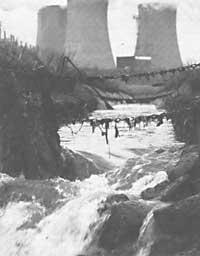At the end of the central life
1986/02/01 Irazabalbeitia, Inaki - kimikaria eta zientzia-dibulgatzaileaElhuyar Fundazioa Iturria: Elhuyar aldizkaria
At the end of this decade, in mid-1989, a unique spectacle is held on the banks of the Ohio River in the United States. In it, a giant crane will take the area of the first American nuclear reactor from ground to a barge bridge. The barge along the Ohio and Mississippi rivers will reach the Gulf of Mexico, after passing the Panama Canal to the Washintong State of the West Coast of the USA. The Columbia River stream will go up to Hansford. It houses the U.S. government's nuclear waste dump.

In Hansford, the area 10 m deep will Iurperará and leave there until the radioactivity descends to a safe level.
This process, which we have explained with ease and agility, will only be part of a program that will cost five years and almost 100 million US$. In addition, the site where the nuclear power plant has remained for 30 years must be free of radioactivity.
There are three ways to act before a nuclear reactor that has taken its own: Dismantling in Shippingport, closing of the reactor and continuous monitoring with appreciation for the surroundings and complete coverage of the plant with cement. The latter two are much cheaper than dismantling. The US Atomic Industrial Forum estimates that the cost of dismantling a pressurized water reactor will be around US$102 million, the cost of covering about US$41 million, and the cost of closing about US$12 million plus US$300,000 for annual maintenance.
The main advantage of dismantling is its political acceptance. Before 2000 another fifteen reactors will arrive at the end of their useful life. Consequently, the future of the US nuclear industry Facing the 20th century, it is largely when the problem of the death of these reactors is solved.
Two years ago began the first work of dismantling of Shipping port. The first step was to really know how many radioactivities there were in it. In short, it was decided that the pressure vessel (the reactor area) should come out entirely. The spring is a cylinder 10 m high and 3 m wide (see figure). It is surrounded by a neutral barrier, a reservoir full of water 1 m thick. The first work to be done with the pressure vessel is to replace water with cement at the neutron barrier, since cement is more effective than water as a radiation barrier.
At that time the pressure vessel will weigh 770 tons. The crane will have jobs to boost this! Although the weight is high, technicians are confident that no problems will occur.
Once the reactor is removed, which is the largest source of radioactivity, operators can handle the remaining steel and cement without special protection. Those responsible for dismantling consider it possible to recover 22,000 tons of steel from the nuclear power plant and sell it as scrap.
It is not yet known whether there will be radioactivities under pressure vessels. According to specialists, the 1 m deep ground layer should be extracted and recycled to reduce at least radiation to an acceptable level. The maximum allowable level is 500 millirems per year. However, the goal is to reach 10 million/year.
Undoubtedly, the biggest problem of a project of these characteristics is the amount of money to use, since 100 million US$ is not a joke. !

Gai honi buruzko eduki gehiago
Elhuyarrek garatutako teknologia





